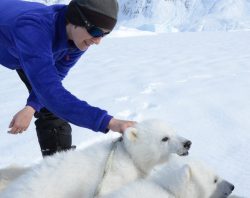
Polar bears are spending more time on land than they did in the 1990s, due to reduced sea ice, new University of Washington-led research has found. Bears in Baffin Bay are getting thinner and adult females are having fewer cubs than was recorded at times when sea ice was more available.
The new study published in Ecological Applications compares polar bear satellite tracking and visual monitoring data from the 1990s with more data collected in recent years.
“Climate-induced changes in the Arctic are clearly affecting polar bears,” said lead author Kristin Laidre, associate professor at UW Aquatic and Fishery Sciences. “They are an icon of climate change, but they’re also an early indicator of climate change because they are so dependent on sea ice.”
The international research team focused on a subpopulation of polar bears around Baffin Bay, a large expanse of ocean situated between northeastern Canada and Greenland. The team tracked the moments of adult female polar bears, assessed litter size, and measured the general health of this subpopulation, starting with data from the 1990s and comparing it to data collected between 2009 and 2015.
Polar bear movements generally follow the annual growth and retreat of sea ice. In early fall, when sea ice is at its minimum, these bears end up on Baffin Island, on the west side of the bay. They wait on land until winter when they can venture out again onto the sea ice.
Read more at UW News »
